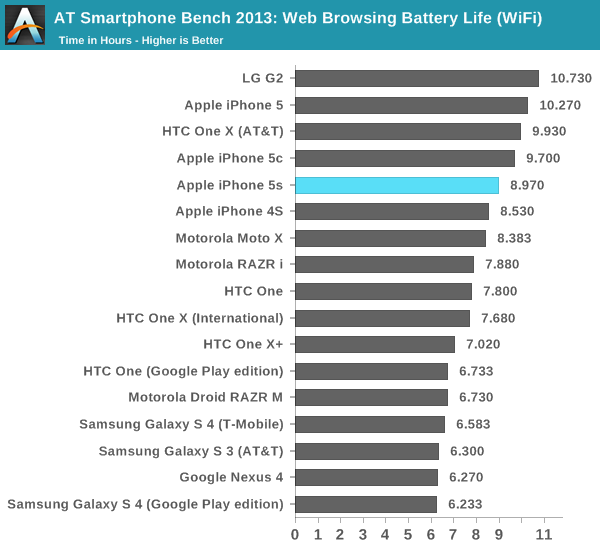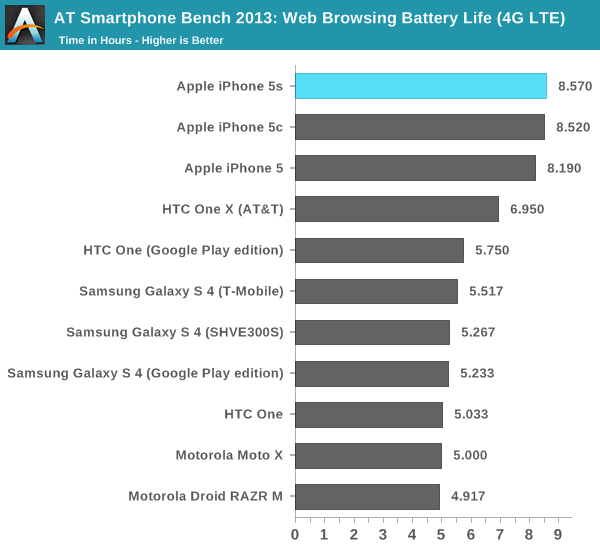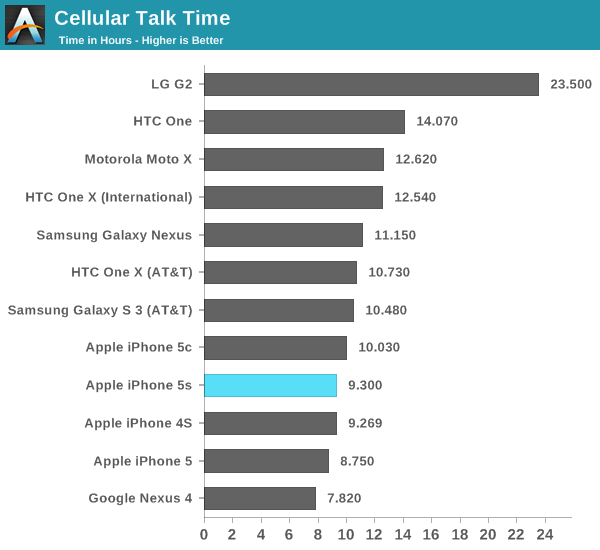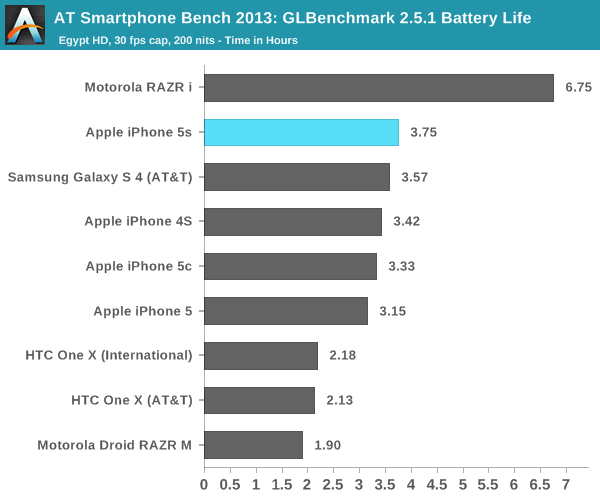The iPhone 5s Review
by Anand Lal Shimpi on September 17, 2013 9:01 PM EST- Posted in
- Smartphones
- Apple
- Mobile
- iPhone
- iPhone 5S
Battery Life
Brian did some excellent sleuthing and came across battery capacities for both the iPhone 5s and 5c in Apple’s FCC disclosures. The iPhone 5 had a 3.8V 5.45Wh battery, while the 5s boosts total capacity to 5.96Wh (an increase of 9.35%). The move to a 28nm process doesn’t come with all of the benefits of a full node shrink, and it’s likely not enough to completely offset the higher potential power draw of a much beefier SoC. Apple claims the same or better battery life on the 5s compared to the iPhone 5, in practice the answer is a bit more complicated.
Unlike previous designs, we’ve never had a half node shrink for an s-SKU. Both the iPhone 3GS and iPhone 4S stayed on the same process node as their predecessor and drove up performance. In the case of the 3GS, the performance gains outweighed their power cost, while in the case of the iPhone 4S we generally saw a regression.
The iPhone 5s improves power consumption by going to 28nm, but turns that savings into increased performance. The SoC also delivers a wider dynamic range of performance than we’ve ever seen from an Apple device. There’s as much CPU power here as the first 11-inch MacBook Air, and more GPU power than an iPad 4.
To find out the balance of power savings vs. additional performance I turned to our current battery life test suite, which we first introduced with the iPhone 5 review last year.
We'll start with our WiFi battery life test. As always, we regularly load web pages at a fixed interval until the battery dies (all displays are calibrated to 200 nits).

The iPhone 5s regresses a bit compared to the 5 in this test (~12% reduction despite the larger battery). We're loading web pages very aggressively here, likely keeping the A7 cores running at their most power hungry state. Even the 5c sees a bit of a regression compared to the 5, which makes me wonder if we're seeing some of the effects of an early iOS 7 release here.
The story on LTE is a bit different. Here we see a slight improvement in battery life compared to the iPhone 5, although the larger battery of the 5s doesn't seem to give it anything other than parity with the 5c:

Our cellular talk time test is almost entirely display and SoC independent, turning it mostly into a battery capacity test:

You can see the close grouping of the smaller iPhones at the bottom of the chart. There's a definite improvement in call time compared to the iPhone 5. We're finally up above iPhone 4S levels there.

Our Egypt HD based 3D battery life test gives us the first indication that Rogue, at least running fairly light code, can be more power efficient than the outgoing 5XT. Obviously the G6430 implemented here can run at fairly high performance levels, so I'm fully expecting peak power consumption to be worse but for more normal workloads there's no regression at all - a very good sign.










464 Comments
View All Comments
flyingpants1 - Wednesday, September 18, 2013 - link
Sorry, no. As much as I hate Apple products.. Apple is killing it with amazing battery life, some of the best IPC, possibly best thermals (and therefore lowest profile) and the BEST performance, all at the same time.Whatever you said about testing multiple phones doesn't matter. It doesn't change facts.
melgross - Wednesday, September 18, 2013 - link
The Moto X hardly competes at all. What he said is true. We're talking an SoC that runs at a lower speed, often considerably slower. What Apple comes out with new iPads in October, they will increase clock speed by 15% or so, and often with more GPU cores as well, usually by 50%. We'll see what the chip can really do then. To be compared to tablets, and come ahead is pretty damning to other processor manufacturers.jeffkibuule - Wednesday, September 18, 2013 - link
When you design both hardware and software, you get optimize far more that when an OEM gets code from Google and *attempts* to get it working best on their hardware. And lets be clear, Android OEMs are clearly throwing more hardware at a software problem, when even a Windows phone with a 1.5 year old SoC in the Lumia 1020 feels far smoother and fluid that the latest Android phone.ananduser - Wednesday, September 18, 2013 - link
Simple...in the current smartphone game of leapfrog, the last one to release its flagship is the top dog. This time the A7 sports a brand new, benchmark "friendly", ARM designed ISA. Next time Exynos will have the upper hand, or Qualcomm, or nVidia.The GPU is made by Imagination not by Apple. The other manufacturers are trying to push their own solution rather than making due with a 3rd party. Technically any other manufacturer could pay Imagination for their Rogue chipset.
Good for you, really.
akdj - Wednesday, October 9, 2013 - link
"This time the A7 sports a brand new, benchmark "friendly", ARM designed ISA. Next time Exynos will have the upper hand, or Qualcomm, or nVidia."You're right---of course, as technology progresses----but the funny thing is, even the 'year old' iPhone 5 holds it's own against even the latest flagship Android devices when it comes down to graphics and browsing/energy (battery life). Apple's NOT just buying off the shelf parts from Imagination----they've hired many a chip expert/designer in house and are now not only optimizing their S/W code to the chip---they're also designing the chips architecture to their system with Imagination and in house skill sets. No other company is doing this yet...and with the new A8 instruction set---this is the best I've seen in 's' updates since the release of the 3GS.
It's a strong move by Apple, these past few years---to apply their own instruction and low level programming as well as SoC design, match up to iOS...the software integrate(ability) with the hardware....and perhaps most importantly, their relationship with carriers (good or terrible, it's irrelevant) as they're huge sellers and contract 'getters' --- and the inability for the carriers to add their own skin has been brilliant. That, to me...and IMHO was one of the great 'feats' Steve Jobs pulled off. Obviously it only initially worked with AT&T----but Verizon almost immediately was beggin to get on board and now they've not only managed to penetrate small mom n pop services in the US---but open themselves up in China, India and Japan to some of the largest carriers (and population served) in the world.
To me, this IS the route Google should take---and reign in both the OEMs and the carriers, but why would they care? They're not hardware makers (for profit anyways)---they're miners, advertiser first aid kits----Data Miners. Your Information is their Money. Period.
Regardless of who makes the SoC, as long as their continues to be bloated Java skins on top of Android, the 'experience' with Apple will be 'better' when it comes to fluency, updates, app selection and app development (Money Paid to developers), et al.
J
Miserphillips - Tuesday, September 17, 2013 - link
iOS 7 very heavily copied Windows Phone.melgross - Wednesday, September 18, 2013 - link
It's nothing at all like that laggard—thankfully.nephipower - Tuesday, September 17, 2013 - link
Can you share how much more space is used on the device because the native apps are now 64 bit?solipsism - Tuesday, September 17, 2013 - link
Like all additional binaries it's negligible. The times you'll notice extra space being used is when you need additional resources, like images for 1x and 2x display (i.e.: Retina) or making a Universal app that needs to support both iPhone and iPad UIs.tech01x - Wednesday, September 18, 2013 - link
Actually, no extra space for images. It's the pointers that are double in size, so depending on the application, there will be additional RAM usage.